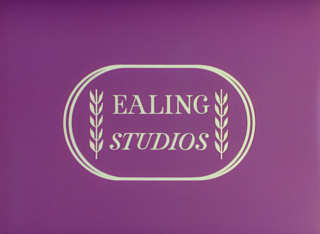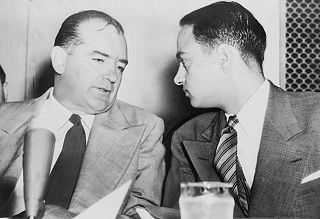
The Lavender Hill Mob is a 1951 comedy film from Ealing Studios, written by T. E. B. Clarke, directed by Charles Crichton, starring Alec Guinness and Stanley Holloway and featuring Sid James and Alfie Bass. The title refers to Lavender Hill, a street in Battersea, a district in London SW11, near to Clapham Junction railway station.

The Ealing comedies is an informal name for a series of comedy films produced by the London-based Ealing Studios during a ten-year period from 1947 to 1957. Often considered to reflect Britain's post-war spirit, the most celebrated films in the sequence include Kind Hearts and Coronets (1949), Whisky Galore! (1949), The Lavender Hill Mob (1951), The Man in the White Suit (1951) and The Ladykillers (1955). Hue and Cry (1947) is generally considered to be the earliest of the cycle, and Barnacle Bill (1957) the last, although some sources list Davy (1958) as the final Ealing comedy.

Lavender is a light shade of purple or violet. It applies particularly to the color of the flower of the same name. The web color called lavender is displayed at right—it matches the color of the very palest part of the lavender flower; however, the more saturated color shown below as floral lavender more closely matches the average color of the lavender flower as shown in the picture and is the tone of lavender historically and traditionally considered lavender by the average person as opposed to those who are website designers. The color lavender might be described as a medium purple or a light pinkish-purple. The term lavender may be used in general to apply to a wide range of pale, light or grayish-purples but only on the blue side. Lilac is pale purple on the pink side. In paints, the color lavender is made by mixing purple and white paint.

Alfie Bass was an English actor. He was born in Bethnal Green, London, the youngest in a Jewish family with ten children; his parents had left Russia many years before he was born. He appeared in a variety of stage, film, television and radio productions throughout his career.
Karla Jay is a distinguished professor emerita at Pace University, where she taught English and directed the women's and gender studies program between 1974 and 2009. A pioneer in the field of lesbian and gay studies, she is widely published.
The Lavender Menace or revolution was an informal group of lesbian radical feminists formed to protest the exclusion of lesbians and their issues from the feminist movement at the Second Congress to Unite Women in New York City on May 1, 1970. Members included Karla Jay, Martha Shelley, Rita Mae Brown, Lois Hart, Barbara Love, Ellen Shumsky, Artemis March, Cynthia Funk, Linda Rhodes, Arlene Kushner, Ellen Broidy, and Michela Griffo, and were mostly members of the Gay Liberation Front (GLF) and the National Organization for Women (NOW).

Patrick David Barr was an English actor. In his career spanning over half a century, he appeared in about 144 films and television series.

The "lavender scare" was a moral panic about homosexual people in the United States government which led to their mass dismissal from government service during the mid-20th century. It contributed to and paralleled the anti-communist campaign which is known as McCarthyism and the Second Red Scare. Gay men and lesbians were said to be national security risks and communist sympathizers, which led to the call to remove them from state employment. It was thought that gay people were more susceptible to being manipulated, which could pose a threat to the country. Lesbians were at less risk of persecution than gay men, but some lesbians were interrogated or lost their jobs.
William Kellner was an Austrian-born art director who worked primarily on British films in the 1940s and 1950s. He began his career as a draughtsman working for Michael Powell and Emeric Pressburger on their films A Canterbury Tale (1944) and I Know Where I'm Going! (1945) and on David Lean's Brief Encounter in 1946. He was also art director on two Ealing Comedies, Kind Hearts and Coronets (1949) and the Lavender Hill Mob (1951). Kellner was nominated for two Oscars, in 1949 for Basil Dearden's Saraband for Dead Lovers and in 1959 for Joseph L. Mankiewicz's adaptation of Tennessee Williams' Suddenly Last Summer. He worked on two Anthony Asquith all-star productions, The V.I.P.s and The Yellow Rolls-Royce, both in 1964, before retiring in 1965.
The 23rd National Board of Review Awards were announced on December 17, 1951.

Lavender Country was an American country music band formed in 1972 whose self-titled 1973 album is the first known gay-themed album in country music history. Based in Seattle, Washington, the band originally consisted of lead singer and guitarist Patrick Haggerty (1944–2022), keyboardist Michael Carr, singer and fiddler Eve Morris and guitarist Robert Hammerstrom. Lavender Country has released two studio albums Lavender Country (1973) and Blackberry Rose (2019). The band has a wide number of members in various cities, with Haggerty having been the only constant member.

Gilbert Baker was an American artist, designer, and activist, best known as the creator of the rainbow flag.

Marie Ney 18 July 1895, in Chelsea, London – 11 April 1981, in London) was a British character actress who had an acting career spanning five decades, from 1919 to 1969, encompassing both stage and screen.

Ivy Bottini was an American activist for women's and LGBT rights, and a visual artist.

Michael Anthony Petrelis is an American AIDS activist, LGBTQ rights activist, and blogger. He was diagnosed with Acquired Immunodeficiency Syndrome (AIDS) in 1985 in New York City, New York. As a member of the Lavender Hill Mob, a forerunner to the AIDS Coalition to Unleash Power, he was among the first AIDS activists to protest responses to the disease. He was a co-founding member of ACT UP in New York City, New York, and later helped organize ACT UP chapters in Portland, Oregon, Washington, D.C., and New Hampshire, as well as the ACT UP Presidential Project. Petrelis was also a founding member of Queer Nation/National Capital, the Washington D.C. chapter of the militant LGBTQ rights organization.
Martin "Marty" Robinson was an American gay activist, "known for his provocative protests."

TSS Canterbury was a ferry completed in 1929 to link the Golden Arrow and La Flèche d'Or trains to form the prestige London–Dover–Calais–Paris service.
The Lavender Hill Mob was a militant gay rights activist group operating in the United States in the 1980s in response to the treatment of the AIDS pandemic. It was founded and led by Marty Robinson.
The Lavender Hill Mob is a play based on the 1951 Ealing comedy film with a screenplay by T. E. B. Clarke, adapted for the stage by Phil Porter.











